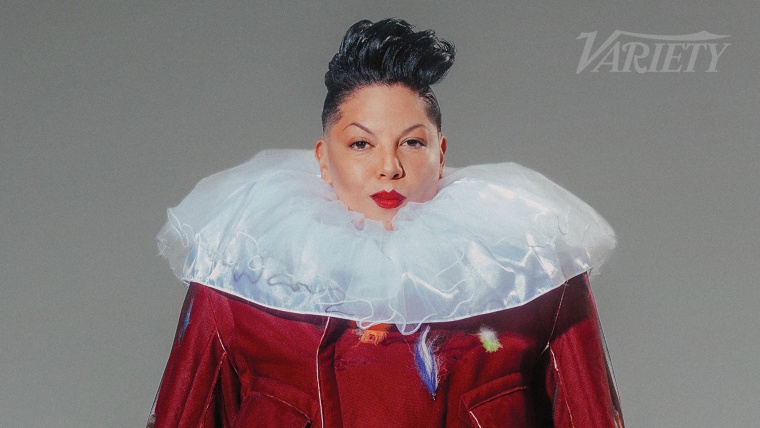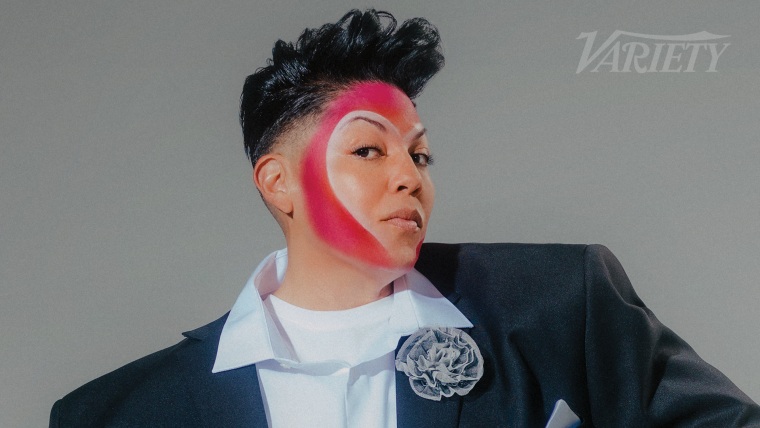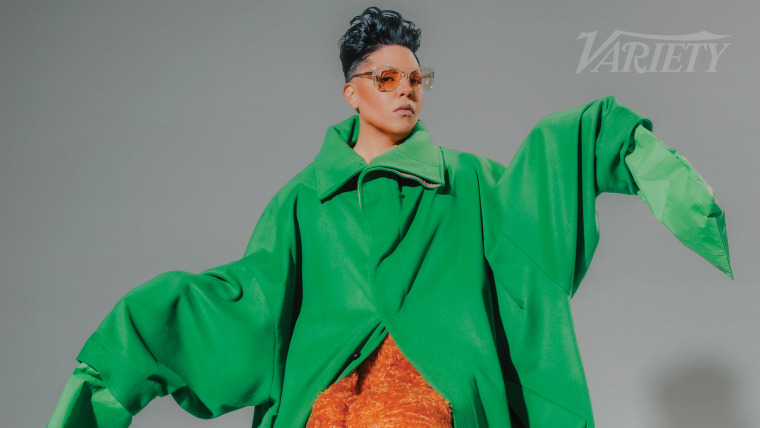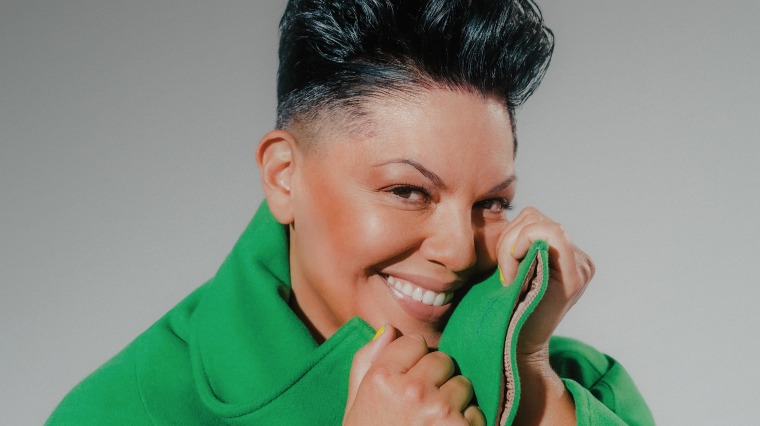In just 10 episodes of “And Just Like That …,” HBO Max’s successful revival of “Sex and the City,” Che Diaz became the most visible (and often most ridiculed) queer character on TV. We’ll get to why in a second. But for those who love Che, do not fear. Sara Ramírez, the nonbinary actor who plays the nonbinary podcaster, comedian and aspiring sitcom star who falls in love with Miranda Hobbes and breaks up her marriage, will be back on the second season of “And Just Like That …” with an even more robust storyline.
When we last saw Che, they were heading to Los Angeles with Miranda (who’d dyed her gray hair red again to represent her sexual awakening), and the new season of “And Just Like That …” will pick up three weeks later. While showrunner Michael Patrick King has just started the writers’ room, Ramírez says he’s offered them a preview: “The first season was judging a book by its cover, and Season 2 is about reading the book.”
King himself is effusive when he speaks about Ramírez — and about Che. “One of my burning passions about Season 2 is Che,” he says. “I want to show the dimension of Che that people didn’t see, for whatever reason — because they were blinded, out of fear or terror. I want to show more of Che rather than less of Che. Like, really.”
The character served as a Rorschach test for viewers. Ramírez’s personal evolution has taken place largely in public after they came to prominence by winning a Tony in 2005 for “Spamalot,” and then co-starring on “Grey’s Anatomy” for 10 seasons, and their casting on the iconic television franchise is unquestionably a leap forward in representation.
And Che certainly had their fans, who appreciated Ramírez’s performance, and understood what King and “And Just Like That …” were doing with the character. But to some old-school “Sex and the City” viewers, Che was a bridge too far in the show’s attempt to be more inclusive by adding characters of color to the core friend group of Carrie (Sarah Jessica Parker), Miranda (Cynthia Nixon) and Charlotte (Kristin Davis). Whether those viewers were turned off by Che’s brash persona or by the show’s semi-cringe approach to Che’s comedy — or because Miranda’s obsession with Che made a fool of the beloved character Steve (David Eigenberg) — Che became an object of cruel mockery, and the progenitor of a million “Hey, it’s Che Diaz” memes and jokes about their Netflix “comedy concert,” as Miranda nerdily called it. When those detractors included LGBTQ viewers, the idea of Che exposed that perhaps those people simply wanted more palatable representation: more white, and more cisgender. For gay Che haters, the call was coming from inside the house.
Months later, King still can’t believe the reaction. “My friend Gregg Araki, he’s a filmmaker, said to me, ‘How does it feel to have created the most polarizing character in all 5,000 shows that are on TV?’” When King asked him to clarify, Araki cited outrageous characters currently on television such as “Vikings who are drinking children’s blood” and so on.
“And what everybody’s concerned about,” King says, “is a nonbinary stand-up comic in the present day.”
Ramírez, 46, largely didn’t do press during “And Just Like That …,” nor have they since. In person, they are earnest and present — and also quick to laugh. They’re eminently “aware that Che made waves,” but have deliberately avoided absorbing specifics of the online tsunami: “Other people’s opinions of a character — that’s not something I can allow into my process.”

“I choose what I receive, right?” they ask rhetorically. “That’s the beauty of being grown — I don’t have to receive everything! And this is Michael’s baby. He created this role. He wrote it. Those are his and his writing team’s jokes.”
Nixon — who says she suggested Ramírez to King after admiring their work for years — is confused about the seismic reaction to the character. “I don’t know what to make of it,” she says. “I mean, I think you’ve got a lot of marriage-police people out there.” Nixon also wonders whether the explosion was because the Miranda-Che relationship is so different from TV’s usual “girl-on-girl action that people across the board think is really sexy.”
“A person like Sara is really threatening and frightening to people,” Nixon says.
During a recent two-and-a-half-hour interview at a bustling restaurant in midtown Manhattan, Ramírez is the opposite of frightening. They discuss their childhood, during which they moved from Mazatlán, Mexico, to San Diego at age 7; their time on Broadway after graduating from Juilliard in 1997; their years on “Grey’s Anatomy” at the show’s height as the bisexual character Callie Torres; their activism as a queer actor; and their mental health struggles, including contemplating suicide early in the pandemic.
And yes, it may be easy to be snarky about Che. But Ramírez playing a sexually free, nonbinary person of color who is proud of who they are shows how far we’ve come — even if there are haters. Ramírez says their approach to the role comes from an activist’s place.
“What I love about Che is that Che is complicated and messy and human. Che is a great reminder that even when we don’t like someone in our community, they still deserve love, safety and joy, like everyone else,” they say. “But the movement for liberation includes everyone, even people we don’t like. This movement, this fight, this party of pride, isn’t just for the people who make us feel cozy and cute — it’s for everyone.”
At the end of production on Season 1, Nixon gave Ramírez a wrap gift with a card that read, “Let’s see all the ways they come up with to torture us if we get picked up for a second season.”
“And that’s how it goes!” Ramírez says. “The conflict is what keeps the story moving.”
• • •
“Sex and the City” aired on HBO from 1998 to 2004. While it was forward-thinking, the show presented the world of New York City as almost unfailingly white. There were gay characters (the late Willie Garson was a standout as Stanford Blatch), but often when “Sex and the City” ventured into queer territory, the results have aged poorly. In the Season 3 finale, for instance, titled “Cock a Doodle Do,” Samantha (Kim Cattrall) has an escalating feud with the transgender prostitutes stationed under the window of her expensive apartment in the Meatpacking District, and she complains that the neighborhood is “tranny by night.”
As a young New York-based actor, Ramírez was watching “Sex and the City” then, and was a fan: “I was falling in love with New York City, and the show only made me fall in love with the city more.”
Ramírez points out that it was “progressive for its time,” and adds, “As somebody who was assigned female at birth, I grew up conditioned around an identity as a woman, and this show really challenged a lot of that conditioning,” they say. “Speak up, be ambitious, have lots of friendships that you commit to — maybe even more than your sexual romantic partners.”
Naturally, though, when King reached out to Ramírez in January 2021 about joining “And Just Like That …,” and they talked over Zoom, Ramírez brought up “the concerns I had around the original ‘Sex and the City,’” and suggested the show work with GLAAD. King took that advice and ran with it. “Sara is really respectful, and really diligent about words,” King says. “They really didn’t want to misstep.”

Upon learning the twist that Miranda would be leaving Steve for Che, Ramírez says they realized it would be a big deal for fans. “It’s going to get a big reaction, a big response,” they remember thinking. “And it sure did!”
Nixon — who came out publicly in 2004, and has been married to Christine Marinoni since 2012 — says during the early stages of planning “And Just Like That …” King asked her a key question: “He was like, ‘Do you want Miranda to be queer or not?’ I was like, ‘Sure, why not!’”
After all, when Nixon looks back, Miranda, despite her interest in men, “had many queer and frankly, lesbianic qualities about her,” she says. “She was a stand-in for the gay woman we didn’t have.” (Nixon adds, “I think Samantha was a different kind of queer.”)
Nixon feels for Ramírez, and all her new castmates. “There is no way to prepare people for the crazy circus that is our world in terms of people’s interest, and people’s focus, and people’s excitement,” Nixon says. “And people’s opinions.”
Ramírez, of course, was on “Grey’s Anatomy” when it was watched by tens of millions of viewers every week: “So yeah, this isn’t my first rodeo, and no, nothing prepares you for it.”
To them, what matters most are the real-life issues LGBTQ people face every day, particularly now, when governors such as Texas’ Greg Abbott and Florida’s Ron DeSantis “are trying to legislate trans and nonbinary people out of existence.”
“If you’re going to get caught up in this character,” Ramírez says, “at least learn about how people like Che Diaz are currently trying to survive escalating attacks on our community.”
According to Ramírez’s friend Qween Jean — a Black trans liberation activist, who also has a cameo in “And Just Like That …” at a rally — Che has been instrumental in bringing the world of “Sex and the City” into the present. “I think we know the history, the foundation, of how that show existed in the past,” Qween Jean says. “I think it’s really fucking amazing to see them on there as a core storyteller. It feels like the change we want to see.”
For Ramírez, though, the issue is a knotty one.
“Visibility isn’t justice,” they say, sounding passionate and clear. “Because visibility without action and consideration for real people that exist means nothing.”
• • •
Having played Callie on “Grey’s Anatomy,” the longest continuously running LGBTQ character in television history, Ramírez is an expert in this field. They identified as bisexual from the time they were in their late teens, while also wondering whether their identity might be more complicated than that. They remember being in their early 20s, and saying to their late best friend, “‘I kind of feel like I’m a bisexual dude in a woman’s body — like I’m a queer dude in a woman’s body.’ I didn’t know what that meant, really.”
In San Diego, Ramírez was “an immigrant kid” who wanted “to look and speak like my mom,” who was “a white Mexican Irish woman with no accent.” In fourth grade, having been recognized as having a gift for singing, they went to the San Diego School of Creative and Performing Arts, and by high school, they were being cast in all the school musicals. “But it’s not like I was Rachel Berry or anything,” Ramírez says, name-dropping the annoying “Glee” character. “It was more just a discovery — an introverted kid who had this voice and enough trauma to dive into emotional acting.” From there, they attended Juilliard, out of which they were cast in Paul Simon’s vaunted, long-gestating (but eventually bombing) Latin musical “The Capeman,” with Marc Anthony. That year, they also had their first on-screen appearance, in a scene with Tom Hanks and Meg Ryan in “You’ve Got Mail,” as a surly Zabar’s cashier.
They worked steadily on Broadway while also traveling to Los Angeles for pilot season. “I have some angel spirits looking over me, because I have been very blessed with pretty consistent work,” Ramírez says.
After they won the Tony in 2005, ABC came calling, telling Ramírez to pick a show on which they wanted to do an arc as a tryout for a regular role. After sifting through DVDs, they chose the brand-new sensation “Grey’s Anatomy.” Of course, “Grey’s” creator Shonda Rhimes had to agree to that selection. Krista Vernoff, then the show’s head writer, now its showrunner, remembers Rhimes flying to New York to see “Spamalot.”
“She came back and said, ‘We’re creating a role for this extraordinary human,’” Vernoff says. “And went on and on about Sara’s talent. Then, Callie was born.”
Late in the show’s second season, Callie, an orthopedic surgeon, was introduced as a love interest for George O’Malley (T.R. Knight). In the fourth season, Ramírez approached Rhimes with a new idea: “I wanted to pursue a storyline where Callie would discover that she was attracted to women as well as men.” Rhimes was game. “She knew I was bi,” Ramírez says.
The significance of Callie’s coming out, as well as her marriage to the character Arizona Robbins (Jessica Capshaw) — superfans called the couple “Calzona” — was profound.
“I don’t think it can be overstated what the social impact of Callie’s bisexuality was on the culture at large,” Vernoff says. “Bisexuality was almost invisible on TV at that point. I personally have two kids who have come out as bisexual, and I don’t think it’s disconnected from Callie and Sara publicly coming out.”
But in May 2016, having spent ages 30 to 40 on “Grey’s,” Ramírez left the show, intent on taking some time off: “I had reached a physical, emotional, mental capacity for playing the character — and had sort of lost myself with it.”
• • •
A few months after their departure, Ramírez, horrified by the combined events of the murders of 49 people in Orlando at the Pulse nightclub and the looming election of Donald Trump, came out as bisexual publicly. In the aftermath, when on their “break, break, break,” as they call it, they cut their hair into “a D.A. undercut (‘D.A.’ is ‘duck ass’).” They’d wanted to make the change earlier, but Rhimes had told them — apologetically, Ramírez makes clear — that the character Callie had long hair. They could cut it, but would have to wear a wig. “I thought, ‘A wig is going to look terrible,’” Ramírez says.
So they kept their hair long: “But when I took my break, I thought, ‘Oh, what better way to reintroduce myself to myself than to actually do something I’ve been wanting to do for years?’”
In 2017, after spending time “learning more about social justice,” Ramírez felt ready to work again. So when the producers of Téa Leoni’s political drama “Madam Secretary” got in touch, they were interested, and took the role of Kat Sandoval, a policy adviser to Leoni’s secretary of state.
The show made it easy to say yes. “I said to them: ‘No dresses. No heels. No femme makeup. Suits and masculine-of-center clothing. That’s where this character lives, and if you want me to play them, then that’s how I need it to be,’” Ramírez recounts. “They said, ‘Let’s ask CBS.’ Then they got back to us and said, ‘CBS says great.’ That was that.”

Ramírez was on “Madam Secretary” for two seasons, having physically transformed from Callie, a bisexual femme, on one of the most watched shows on TV, to the gender-nonconforming Kat. Did that feel like a radical act?
They vehemently disagree that it did — or does now. “The real risk for me was more about career,” Ramírez says. “But in terms of how it impacts the world, it did not feel radical at all.”
• • •
The early months of the pandemic were tough for Ramírez. So much so that in May 2020, they found themselves contemplating suicide late one night. “I remember calling the National Suicide Hotline for the very first time,” they say quietly. “I called some folks, but their phones were off, and I thought, ‘Well, there’s this hotline. …’
“This person really talked me off a ledge, and got me back into my body. I could acknowledge my feelings without becoming them, and it was really helpful. I was particularly vulnerable at that time, and I sought out support. I got that support, but it was a really rough year where, for the most part, I had to release all attachments to permanence in every direction.”
The pandemic, along with “the violence in our country, and grappling with the anti-Blackness that permeates our society so deeply,” had served as a trigger for their “own personal trauma” from childhood. “It just painted a picture of the world that I wasn’t sure I wanted to be a part of,” Ramírez says.
One thing that helped was taking part in protests during that summer’s Black Lives Matter uprising. Ramírez had privately been using “they/ them” pronouns for a year when, in August 2020, they posted a selfie to Instagram, with this poem as a caption: “In me is the capacity to be / Girlish boy / Boyish girl / Boyish boy / Girlish girl / All / Neither #nonbinary.”
They smile as they report the post wasn’t actually meant to announce anything. “An Instagram post is just an Instagram post,” Ramírez says. “It’s a thought in a moment of a day. But it was a powerful one, I guess, to certain people.”
Regardless, to the world, Ramírez had declared they were nonbinary. So five months later, when “And Just Like That …” approached them to play Che, King says it was with the specific intention of casting them. “It was crucial that it be them, or I wouldn’t have done the character. I would have found something else,” he says. “But I really wanted Sara.”
“Sex and the City” thrived on HBO for six seasons, drawing millions of fans as it became the cultural touchstone it remains today. Knowing that, how long can Ramírez picture being on “And Just Like That …”?
“Again, I have learned my lesson around attachment to permanence, so I’m open to what’s meant to be,” Ramírez says with a laugh. “I’ve worked hard to get to where I am, and I was also born with a lot of privileges. But I feel like I’m in a place in my life where I don’t have to take jobs that I don’t want to do. I think I’ve earned that right. So we’ll see where this story goes.
“We’ll take it one season at a time, how about that?”
